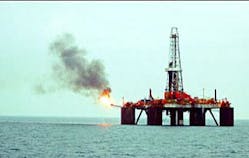Spain appears headed for an oil production boost in the second half of 2006 when idle Amposta oil field in the Gulf ofValencia returns to production.
A Royal Dutch Shell PLC unit discovered Amposta, formerly known as Amposta Marine, in 1970 and produced it, mostly through 6 of 12 wells drilled, during 1973-89. The best wells tested at rates of 20,000 b/d.
The fractured and brecciated Lower Cretaceous Montsia dolomitic limestone reservoir with a water drive was then estimated to have 100 million bbl in place. When abandoned, it had produced 56 million bbl of oil with less than 1% water and a 2% drawdown on the reservoir’s original pressure of 2,743 psi. The oil is 17.5° gravity with 5.5% sulfur.
Reprocessed 3D seismic data that a Shell unit acquired in 1982 indicated that original oil in place might have been 140 million bbl. Reprocessing identified five separate structures lying in crestal positions, or attics. Two structural culminations were recognized in the early years (OGJ, Mar. 29, 1976, p. 197).
Eurogas Corp., Calgary, has a project to convert the oil reservoir to gas storage with a working gas capacity of 1 billion cu m. The platform is in 60 m of water 21 km offshore in the Mediterranean.
In January, however, Eurogas’s $13.4 million Castor-1 well flowed 2,800 b/d of oil from 53 m of net Montsia reservoir and at TVD 1,821 m below sea level never reached the oil-water contact. Tests indicated it can deliver in excess of 10,000 b/d of oil from one attic.
Production, injection
Eurogas in March acquired 125 sq km of 3D seismic data. It plans to place Castor-1 on production in mid-2006 while simultaneously drilling laterals to recover 6-35 million bbl of oil from the attic crests.
Serving Amposta field will be a $10 million wellhead support structure-drilling platform alongside a floating storage vessel and a shuttle tanker.
Eight horizontal or deviated wells, including the attic oil recovery wells, will inject and withdraw gas. One vertical disposal-observation well is planned.
Peak design is 880 MMcfd for 40 days for delivery by 34-in. pipeline to Enagas SA at a shore terminal south of Alcanar. This volume could compensate for a delivery shortfall, for example, the size of the capacity of the Maghreb pipeline or Spain’s Cartagena regasification plant.
Oil depletion would occur and gas storage operations begin in 2009. Spain’s gas consumption is expected to double by 2011, and Amposta will meet 25% of the country’s future storage requirements, Eurogas said.
Eurogas holds 72% working interest in the gas storage project and 100% working interest in all hydrocarbons produced on the permit.
OGJ estimated that Spain’s output averaged 5,000 b/d of oil and 3 bcf/month of gas in the early months of 2005 (OGJ, July 11, 2005, p. 62). ✦



